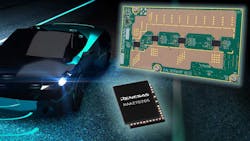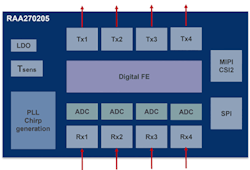Radar Transceivers Claimed to Have Highest Accuracy, Lowest Power Consumption
Check out more of our coverage of Electronica 2022. This article is also part of TechXchange: Automotive Radar
Radar plays an important role in automated driving because it can accurately measure the distance, position, and velocity of targets. On this front, Renesas Electronics enters the automotive radar market with the introduction of a 4x4-channel, 76- to 81-GHz transceiver designed to meet the requirements of advanced driver-assistance systems (ADAS) and Level 3 and higher autonomous-driving applications.
The company will incorporate the new RAA270205 high-definition radar transceiver into its growing sensor-fusion portfolio, which combines radar, vision systems, and other sensing modalities.
The transceiver, designed in cooperation with Steradian Semiconductors (acquired by Renesas earlier this year), was featured recently in the firm’s product showcase at electronica in Munich, Germany.
Best-in-Class Accuracy
Today’s radar architecture is based on a set of separate radar modules distributed around the vehicle. Each module has its own radar transceiver and the capability to process the detected data on board, either using a single chip or with a separate microcontroller or system-on-chip (SoC) on the same module.
The new transceiver monolithic microwave integrated circuit (MMIC) is said to be well-suited for imaging radar, long-range forward-looking radar, and 4D radar. However, it also can be used for corner and central-processing radar architectures, the so-called “satellite” automotive radar systems.
Equipped with 4Tx and 4Rx channels, the 28-nm RFCMOS RAA270205 supports up to 16 multiple-input multiple-output (MIMO) channels and can be cascaded to enable higher channel count and better radar resolution.
The first in the family, the RAA270205 features what Renesas says is best-in-class accuracy with up to 5 GHz of bandwidth, and a 112.5-Msample/s analog-to-digital converter (ADC) sampling rate that’s nearly 3X faster than competing devices.
Operating in the 76- to 81-GHz frequency band, the device supports a high number of channels. Renesas claims it offers the best phase noise and linearity in the industry. What’s more, the transceiver high reliability is based on an optimal combination of RF and digital macros for radar processing.
Lower Power and Cost
With integrated multichannel high-resolution ADCs, VCOs, PLL, PAs, LNAs, phase shifters, and signal-processing accelerators, the device enables OEMs to significantly reduce the overall system cost, footprint, and power consumption. Power consumption of 1.2 W is 50% lower than comparable transceivers. Moreover, the part delivers a noise figure of 9 dB, which is 3 dB less than other radar transceivers, according to Renesas.
Its chirp rate of up to 300 MHz/µs improves radar resolution and object detection. In radar, a chirp is a signal in which the frequency increases (up-chirp) or decreases (down-chirp) with time
“Today’s radar transceiver MMICs must achieve higher definition to support the high-accuracy requirements of ADAS and autonomous driving safety platforms,” said Vivek Bhan, Senior Vice President and Deputy General Manager of Renesas’ Automotive Solution Business Unit. “Working in close collaboration with Steradian, we are expanding our sensor-fusion offerings with a focus on functional safety and low power consumption to help our customers lower their development costs and improve time-to-market.”
Renesas provides radar systems with centralized processing. This consists of several satellite units with their respective radar transceivers connected to a central processing unit based on the company’s R-Car V4H SoC. The R-Car V4H achieves deep-learning performance of up to 34 teraoperations per second (TOPS), enabling high-speed image recognition and processing of surrounding objects by automotive cameras, radar, and LiDAR.
Thanks to a high level of integration, the R-Car V4H allows manufacturers to develop cost-competitive, single-chip, ADAS electronic control units (ECUs). These ECUs may support driving systems appropriate for automated-driving Levels 2+ and Level 3, including full Euro NCAP (New Car Assessment Programme) 2025 features.
In the next years, radar modules will be added whereby they will go from a basic configuration, with only a forward-looking radar with level L1 autonomy and a 1 to 4 NCAP rating, to up to L2+ autonomy and NCAP 4-5 in standard cars and L3-L4 of autonomy and NCAP 5 in the premium segment.
Renesas has plans to combine the RAA270205 transceiver with other compatible devices from its portfolio to support automotive radar systems. These combinations will include its “Satellite Radar System for AD/ADAS,” which will be available in Q2/2023.
A variety of safety mechanisms, such as on chip loop-back test, voltage/clock monitors, and digital error checkers, are implemented in the MMIC to satisfy ISO 26262 functional-safety requirements.
Availability
The RAA270205 will be available in 1Q/2023 in sample quantities, with commercial production planned for 2024. The transceiver comes in a small, easy-to-integrate embedded wafer-level ball-grid array (eWLB) package, measuring only 7.6 × 5.6 mm. It will be fully compliant with automotive industry requirements such as IATF 16949, AEC-Q100 Grade 2, and ASIL B.
Check out more of coverage of Electronica 2022. Read more articles in TechXchange: Automotive Radar

